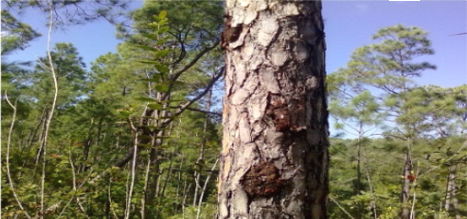Diagnosis of two sources nurseries of Pinus tropicalis Morelet and Eucalyptus urophylla S.T. Blake in the Integral Forest Enterprises “Macurije”
Main Article Content
Abstract
Article Details
As part of the submission process, authors are required to check off their submission meets all the elements listed below, and they know that shipments that do not meet these guidelines may be returned to the author.
DECLARATION OF ORIGINALITY
The author Authorship and author who refers or shipping to UPR CIFAM, CERTIFY:
- That each of the people in it are listed as author or author has contributed directly to the intellectual content of the work, approves the contents of the manuscript is submitted to editorial process and gives its consent that their name appears on the authorship thereof.
- That the request has not been previously published, it is not under review in another journal, nor included in another paper accepted for publication by another publisher.
- That in the event that the content has been presented in a communication or congress, the current request is a substantial modification thereof and has properly been cited text on which it is based. This circumstance an explanation is provided to the publisher at the right place of the submission form (box "Comments to the Editor").
- That each of the people listed as author or author agrees not to submit this work for consideration by another publication while in CIFAM Journal editorial process.
- It has been recognized in a note the article, by way of thanks, the contribution of those which are not signatories to the same or responsible for the final version, have contributed substantially to the development of labor so and have given their permission to such mention.
- Data and publications in which the information contained in the work, or who have had a significant influence on it is based have been cited in the text and in the list of references, being responsible, in respect of rights author refers, of any dispute or claim relating to intellectual property rights, exonerating from liability CIFAM journal.
Likewise, the author who submitted work must confirm compliance with the following points:
- The text meets the style and bibliographic requirements outlined in the "Uniform requirements for manuscripts submitted to the journal."
- If the text is attached to a section of the journal subject to peer review (see policy sections), has made sure to follow the directions given in Ensuring Blind Review.
- The file is sent in DOC or DOCX format.
- Where it has been possible, they have been added and DOI web addresses in the references.
Copyright Notice:
Authors who publish in this journal agree to the following terms:
- The authors retain copyright, ensuring Journal CIFAM the right of first publication of the work that refer to the magazine to be submitted to the editorial process.
- Authors know that his work is published under a Creative Commons License Attribution-NonCommercial 4.0 International that allows others to share it with a recognition of the authorship of the work and its initial publication in this journal.
- The authors give to the CIFAM Journal the rights of exploitation of the work which has been published in this journal, authorizing the publishing of it for the exercise of a free reproduction, distribution and public communication without commercial purposes.
- Authors know that their work will be stored on servers and reproduced in digital format for inclusion in institutional repositories and databases that will facilitate free access to the full text of the work.
- Authors can distribute the version of the work published in CIFAM Journal (for example, to an institutional repository or publish it in a book), with an express acknowledgment of its initial publication in this journal.
References
Aldana, E; Puentes, M; Romero, L. Informe Final Proyecto de Ordenación EFI Macurije. Ministerio de la Agricultura, 2006.
Berazaín, R. et al. Lista Roja de la Flora Vascular Cubana. Documentos del Jardín Botánico (Gijón), 2005, 4, 1-86.
Calero, A. Técnicas de muestreo. La Habana, Cuba: Editorial Pueblo y Educación, 1978.
Calliez, A. Predicción del volumen forestal y predicción del rendimiento con referencia especial a los Trópicos. Predicción del rendimiento. 22. FAO. Roma, 1980.
Cruz, Y. Metodología para la elaboración de estrategias de marketing forestal sostenible en Cuba. Tesis Doctoral inédita en Ciencias Forestales, 2010.
Doruska, D.F. y Burkhart, H.E. Modeling the diameter and locational distribution of branches within the crowns of loblolly pine trees in unthinned plantations. Canadian Journal or Forestry Research, 1994, 24, 2362-2376.
Gower, S.T. y Norman, J.M. Rapid estimation of leaf-area index inconifer and broad-leaf plantations. Ecology, 1991, 72, 1896-1900.
Margolis, H., et al. Leaf area dynamics of conifer forests. In: Smith W.K. y T.M. Hinckley (Eds.). Eco Madera y Bosques, 2012, 18(1),25-41 39.
Notario, A. Investigación científica en las institucionesde educación superior.Medellín, Colombia: Ediciones Fundación Educativa Ensumer, 2004.
NRAG 595. Norma ramal del ministerio de la agricultura. Tratamientos silvicultura. Coníferas y Latifolias. Raleos en Plantaciones y bosques naturales, 1982.
Padilla, G. Tablas dasométricas para plantaciones de Pinus tropicalis Morelet. Tesis Doctoral inédita en Ciencias Forestales, Universidad de Pinar del Río, 1999.
Peñalver, A. Estudio del Crecimiento y Rendimiento de las plantaciones de Eucaliptus sp de la provincia de Pinar del Río. Tesis Doctoral inédita en Ciencias Forestales. Universidad de Pinar del Río, 1991.
Sordo, L. Taller de silvicultura. Semillas forestales. Cienfuegos, 2015.
Suárez, M. T; Palenzuela, L. y Roldán, P.P. Manual para la Ejecución de la Ordenación Forestal. Reelaborado basándose en el trabajo original de Alexander Eremeev- asesor internacional del equipo técnico de Ordenación Forestal, 2000.


